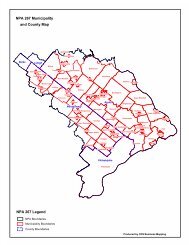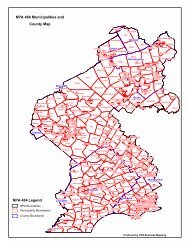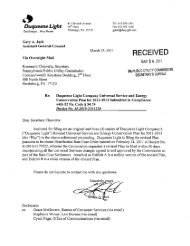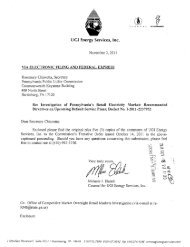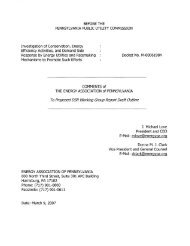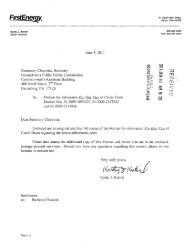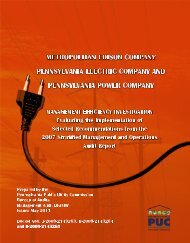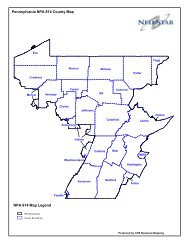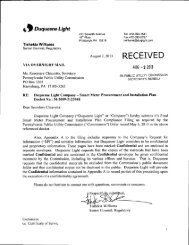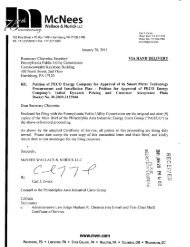2010 Report - Pennsylvania Public Utility Commission
2010 Report - Pennsylvania Public Utility Commission
2010 Report - Pennsylvania Public Utility Commission
Create successful ePaper yourself
Turn your PDF publications into a flip-book with our unique Google optimized e-Paper software.
AECs are earned when a qualified facility generates 1,000 kilowatthours (kWh) of electricitythrough either estimated or actual metered production. An AEC is a tradable certificate thatrepresents all the clean energy benefits of electricity generated from a facility. An AEC can besold or traded separately from the power. AECs are generally purchased by EDCs and EGSs inorder to meet the percentages required under AEPS for any given energy year. The AECs can betraded multiple times until they are retired for compliance purposes.On June 3, <strong>2010</strong>, the <strong>Commission</strong> approved Clean Power Markets (CPM) to be the AlternativeEnergy Credit Program Administrator through 2013. CPM, which had been the administratorsince 2007, verifies that EGSs and EDCs are complying with the minimum requirements of Act213. The <strong>Commission</strong> also has chosen PJM’s Generation Attribute Tracking System (GATS) toassist EDCs in their compliance with the requirements of Act 213, including registration ofprojects.On June 22, 2006, the <strong>Commission</strong> approved Final Regulations promoting onsite generation bycustomer-generators using renewable resources and eliminating barriers which may havepreviously existed regarding net metering. The regulations also provide for metering capabilitiesthat will be required and a compensation mechanism which reimburses customer-generators forsurplus energy supplied to the electric grid. 28The <strong>Commission</strong> also approved Final Regulations, on Aug. 17, 2006, which governinterconnection for customer-generators. The regulations promote onsite generation by customergeneratorsusing renewable resources, consistent with the goal of Act 213. The regulations striveto eliminate barriers which may have previously existed with regard to interconnection, whileensuring that interconnection by customer-generators will not pose unnecessary risks to the electricdistribution systems in the Commonwealth. 29On Sept. 25, 2008, the <strong>Commission</strong> adopted a Final Rulemaking Order pertaining to the AEPSobligations of the EDCs and EGSs. 30Act 35 became effective on July 17, 2007, and amends provisions of Act 213, including definitionsof customer-generators, the reconciliation mechanism for surplus energy supplied through netmetering and the price to be paid for such surplus energy. Pursuant to Act 35, on Feb. 26, 2009,the <strong>Commission</strong> approved standard Interconnection Application Forms and a Policy Statementaddressing Interconnection Application Fees. Act 35 also expanded the definition of Tier Ialternative energy sources to include solar thermal energy.As of May 18, <strong>2010</strong>, <strong>Pennsylvania</strong> had certified 1,458 alternate energy facilities, many of whichare located within the state. For additional information, visit the <strong>Commission</strong>’s AEPS website athttp://paaeps.com/credit/.28 Docket No. L-00050174; 52 Pa. Code §§ 75.11-75.15.29 Docket No. L-00050175; 52 Pa. Code §§ 75.21-75.40.30 Docket No. L-00060180; 52 Pa. Code §§ 75.61-75.70.16<strong>Pennsylvania</strong> <strong>Public</strong> <strong>Utility</strong> <strong>Commission</strong>



